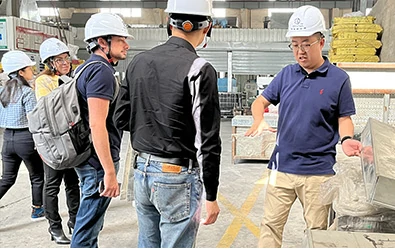loading...
- No. 9, Xingyuan South Street, Dongwaihuan Road, Zaoqiang County, Hengshui, Hebei, China
- admin@zjcomposites.com
- +86 15097380338
- Welcome to visit our website!
Advancements in Fiber Reinforced Polymer Rebar for Enhanced Structural Durability and Strength
The Rise of Fiber Reinforced Polymer Rebar in Construction
In the ever-evolving realm of construction materials, Fiber Reinforced Polymer (FRP) rebar has emerged as a groundbreaking innovation, transforming how structures are built and reinforced. Unlike traditional steel rebar, which has been the cornerstone of concrete reinforcement for decades, FRP rebar offers a unique set of advantages that address many of the limitations associated with its metal counterpart.
The Rise of Fiber Reinforced Polymer Rebar in Construction
One of the most significant benefits of FRP rebar is its resistance to corrosion. In traditional construction, steel rebar is susceptible to rust and degradation when exposed to moisture and various chemicals, which can compromise the structural stability of buildings and infrastructures like bridges, tunnels, and parking structures. In contrast, FRP rebar is inherently resistant to these threats. This durability translates to longer-lasting structures with lower maintenance requirements, making FRP an economically advantageous choice in the long term.
fiber reinforced polymer rebar

Moreover, FRP rebar contributes to sustainability efforts in construction. With a growing emphasis on eco-friendly practices, the use of FRP materials aligns well with green building principles. The production of FRP rebar generates less environmental impact compared to the extraction and processing of steel. Additionally, since the lifespan of FRP rebar is significantly longer due to its corrosion resistance, the overall demand for raw materials is reduced, contributing further to sustainability.
Thermal properties are another area where FRP rebar shines. Unlike steel, which conducts heat and can lead to thermal expansion issues within concrete structures, FRP has a low thermal conductivity. This characteristic helps maintain the integrity of concrete in varying climatic conditions, reducing the risk of cracking and other thermal-related issues. As a result, structures reinforced with FRP rebar can offer better performance under extreme temperatures.
Despite its numerous advantages, FRP rebar is not without challenges. The initial cost of FRP materials can be higher than traditional steel; however, when considering the long-term benefits including reduced maintenance costs and longer service life, the investment may prove to be worthwhile. Furthermore, there is still a need for widespread industry acceptance and understanding of how to best incorporate FRP rebar into design practices, which can slow its adoption.
In conclusion, Fiber Reinforced Polymer rebar represents a significant advancement in construction technology. Its lightweight, corrosion-resistant properties, sustainability benefits, and superior thermal performance provide compelling reasons for the construction industry to consider it as an alternative to steel rebar. As ongoing research and development continue to enhance the performance characteristics and cost-effectiveness of FRP materials, it is likely that FRP rebar will play an increasingly prominent role in building the infrastructure of the future. With the shifting landscape of construction toward more resilient and sustainable practices, embracing innovations like FRP rebar may become essential for achieving optimal structural solutions in a rapidly changing world.
-
The Rise of FRP Profiles: Strong, Lightweight, and Built to LastNewsJul.14,2025
-
SMC Panel Tanks: A Modern Water Storage Solution for All EnvironmentsNewsJul.14,2025
-
GRP Grating: A Modern Solution for Safe and Durable Access SystemsNewsJul.14,2025
-
Galvanized Steel Water Tanks: Durable, Reliable, and Ready for UseNewsJul.14,2025
-
FRP Mini Mesh Grating: The Safer, Smarter Flooring SolutionNewsJul.14,2025
-
Exploring FRP Vessels: Durable Solutions for Modern Fluid HandlingNewsJul.14,2025
-
GRP Structures: The Future of Lightweight, High-Performance EngineeringNewsJun.20,2025
